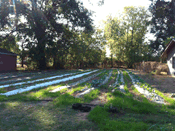Serenity Luckett, principal of Brown Elementary, looked down at the dirt of the soon-to-be-garden she was watering to see the water roll into pools on top of the soil. After a few minutes of watering and some tilling, most of the car-sized plot was ready for planting. Parents and older volunteers planted small, grassy shrubs around the border while School Resource Officer Diana Hollace showed students how to plant pansies: Squeeze the bottom of the plastic planter to loosen the plant, make sure the hole isn't too deep and don't worry about that spider, they protect the plants from pests, she said.
On an early October morning, a small but dedicated, group of students, parents and school faculty gathered in front of Brown Elementary School to plant a community garden called the People's Garden. People's Gardens were also planted at Galloway and Rowan Elementary Schools.
Sponsored by the U.S. Department of Agriculture, The People's Garden Initiative is funded through an America's Promise Alliance grant that Operation Shoestring is administering.
The People's Garden at Brown Elementary is comprised of two gardens—a pollination garden with flowers and shrubs, and a vegetable garden with broccoli, lettuce and red cabbage. Not only are the two gardens mutually beneficial, they also teach the students about pollination and how gardens grow.
"The gardens teach parents and children a way of giving back to the community and helps them take ownership in their community," Promies Zone Coordinator Rolanda Alexander of Operation Shoestring said. "They also teach kids how to plant and to help each other."
Alexander said the community has plans to plant a larger food garden in spring 2011, creating a sustainable food source for the community.
The People's Gardens are part of the growing trend of urban gardening throughout Jackson. Mayor Harvey Johnson Jr. announced the city's Urban Garden Initiative in April and has planted gardens, so far, on Tougaloo Street and on the corner of Capitol and Adams streets. A garden at Westside Community Center is in the early plantings stages.
The city hopes to have a garden in every ward by spring 2011.
"The gardens are targeting younger people, although support of any ages is encouraged," Jackson Policy Coordinator Beth Hamilton said. "Mississippi used to be a huge agricultural state, and now the average farmer is in his or her 50s. These gardens could open doors for kids they didn't know existed."
Aside from teaching kids about gardening, the goals of the city's Urban Garden Program are to create bonds between generations, to create access to fresh fruit and vegetables, to teach children about entrepreneurship and to create a sense of pride in communities.
"We'll know (the gardens) are successful if support continues and people are still involved a year or two from now," Hamilton said.
Jackson Community Design Center Research Associate Whitney Grant, who is assisting with the city's urban-garden program, said support structures are important for the garden's success.
"The idea is to build things to make people feel like they should be occupying the space and to help the people supporting the gardens," she said. "So (they should include) locked storage, facilities for sinks, picnic tables and pavilions. If the idea is for these to truly be community gardens, they need to be built in a way that the community wants to be there and can comfortably work in a garden."
Grant added that garden volunteers currently have to load materials into their cars and take them offsite because there is no onsite storage, and this puts more responsibility on a few individuals.
Denver Urban Gardens, based in Denver, Colo., is a successful urban garden model. The nonprofit began in 1985 with three gardens within city limits and now oversees 100 gardens throughout the Denver metro area, 80 percent of which are in low- to moderate-income neighborhoods.
The program has 15 more gardens planned for 2011.
"I think one of the reasons that our model has been so successful is that we never go into a neighborhood and decide as an organization that it needs a community garden. We wait until the community comes to us and requests our assistance," Communications Coordinator Abbie Harris said.
DUG is involved with the process of creating the garden, and garden leaders, who are volunteers from the community, handle the day-to-day operations of the garden.
The Colorado School of Public Health, in partnership with DUG, recently completed the Gardens for Growing Healthy Communities study, which began in 2004, on how urban gardens affect communities.
"I think one of the really powerful things about gardens is that it's not only a place where people can grow fresh, healthy food close to home, it's also a gathering place... (and) a sanctuary in what's often a harsh environment," Harris said.
"It's a place for neighbors to connect with one another, to connect back with nature, to meet one another and to enjoy each others' company."
If you have an idea for where an urban garden could grow or want to volunteer at one of the city's existing gardens, call Beth Hamilton at 601-960-0462. To read more about the Gardens for Growing Healthy Communities study at the Denver Urban Gardens website, visit http://www.dug.org/gghc.



Comments
Use the comment form below to begin a discussion about this content.